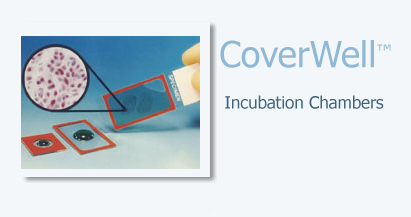CoverWell™ incubation chambers
CoverWell™ incubation chambers are reusable, easy to apply chambers that attach without the use of adhesive. CoverWells™ enclose a large sample area with a small reagent volume and preserve kinetic (non-capillary) fluid dynamics for better reagent mixing and lower backgrounds within the chamber for more uniformly sensitive assays. These ready-to-use chambers are designed expressly for in situ hybridization and immunocytochemistry.
Features
- Eliminate precipitate deposits on specimens by incubating slides and specimens upside down during enzymatic color precipitation reaction
- Provides an exceptionally secure seal during submerged water bath and/or high temperature incubations
- RNase and DNase free
- Easily removed
- Adheres to wet or dry surfaces
Please note, that we can customize chamber shape, size and depth for your application.

Products
PC50-CoverWell Incubation Chambers, 13mm Dia. X 0.5mm ID, 22mm X 25mm OD / Approx. Vol. 50UL - 50 PACK
| Id | 645501 |
| Title | PC50-CoverWell Incubation Chambers, 13mm Dia. X 0.5mm ID, 22mm X 25mm OD / Approx. Vol. 50UL - 50 PACK |
| Substrate | |
| Format | |
| Mean Diameter | |
| Color Labeling | |
| Surface Modifications | |
| Solids Content | |
| Product Dimensions | |
| Packaging | |
| Packaging Volume | |
| Package Weight | |
| Dimensions | |
| Hts Code | |
| Pads Wells | |
| Pad Size | |
| Well Format | |
| Product Thickness | |
| Description | CoverWell incubation chambers are reusable, easy to apply incubation chambers that attach without the use of adhesive. |
| Image |
References
- Fa, N., Lins, L., Courtoy, P. J., Dufrêne, Y., Van Der Smissen, P., Brasseur, R., … Mingeot-Leclercq, M.-P. (2007). Decrease of elastic moduli of DOPC bilayers induced by a macrolide antibiotic, azithromycin. Biochimica Et Biophysica Acta, 1768(7), 1830–1838.
- Gachet, Y., & Hyams, J. S. (2005). Endocytosis in fission yeast is spatially associated with the actin cytoskeleton during polarised cell growth and cytokinesis. Journal of Cell Science, 118(Pt 18), 4231–4242.
- Hinds, K. A., Hill, J. M., Shapiro, E. M., Laukkanen, M. O., Silva, A. C., Combs, C. A., … Dunbar, C. E. (2003). Highly efficient endosomal labeling of progenitor and stem cells with large magnetic particles allows magnetic resonance imaging of single cells. Blood, 102(3), 867–872.
